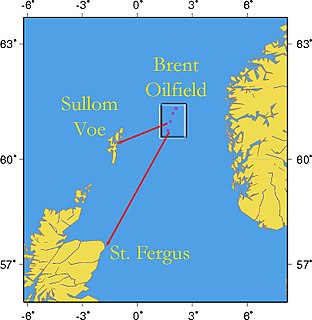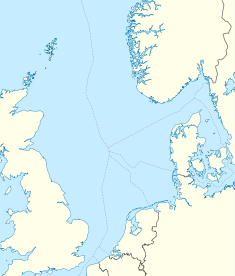
Piper Alpha was an oil platform located in the North Sea approximately 120 miles (190 km) north-east of Aberdeen, Scotland. It was operated by Occidental Petroleum (Caledonia) Limited and began production in 1976, initially as an oil-only platform but later converted to add gas production.

The Brent field is an oil and gas field located in the East Shetland Basin of the North Sea, 186 kilometres (116 mi) north-east of Lerwick, Shetland Islands, Scotland, at the water depth of 140 metres (460 ft). The field operated by Shell UK Limited was discovered in 1971 by semi-submersible drilling rig "Staflo" and was once one of the most productive parts of the UK's offshore assets but has reached the stage where production is no longer economically viable. Decommissioning of the Brent field is ongoing and will be completed in the early 2020s. The discovery well 211/26-1 was drilled in 1971 by the semi-submersible drilling rig "Staflo". This was a major surprise at the time as the nearest land in Scotland and Norway is composed of granite and other non reservoir metamorphic rocks.

The Brae field is a Scottish oil field. The name comes from a Scots language word for hillside. The field was discovered in 1974 by well 16/7-1 drilled by a semi-submersible rig Odin Drill for operator Pan Ocean.

The Auk Oilfield is situated 249 kilometres (155 mi) east, southeast of Aberdeen, Scotland, in block number 30/16. It was operated by Shell UK Exploration and Production Ltd, in 50% partnership with Esso until October 2006 when it was bought by Talisman Energy, and is now licensed by Repsol Sinopec Resources UK Ltd. It was discovered in October 1970 in a water depth of 182 metres. The oil reservoir is a Rotliegendes sandstone overlaid with Zechstein carbonates and ls located at a depth of 2,316 metres (7,598 ft). Estimated ultimate recovery is 88.5 million barrels of oil. The oil has an API gravity of 38 degrees and a gas-oil-ratio of 155 scf/bbl.
The Dunlin oilfield is situated 195 km northeast of Lerwick, Shetland, Scotland, in block number 211/23a and 211/24a. It was originally operated by Shell but was sold in 2008 and is now operated by Fairfield Energy and partners MCX.

The Cormorant oilfield is located 161 kilometres (100 mi) north east of Lerwick, Shetland, Scotland, in block number 211/26a. It was discovered in September 1972 at a depth of 150 metres (490 ft). Estimated recovery is 90 million barrels of oil. The oil reservoir is located at a depth of 2,895 metres (9,498 ft). The discovery well, 211/26-1 was drilled by semi submersible rig Staflo.

Platform Name - Tern Alpha.

Valhall is an oil field in the Norwegian sector of the North Sea. Discovered in 1975, production began in 1982 and is expected to continue until 2050. Valhall is located in 70 metres of water. It produces from chalk in the Tor and Hod Formations of Late Cretaceous age. The reservoir depth is approximately 2 400 metres.

The Forties Oil Field is the largest oil field in the North Sea, 110 miles east of Aberdeen. It was discovered in 1970 and first produced oil in 1975 under ownership of British Petroleum, now called BP.

The Miller oilfield is a deep reservoir under the North Sea, 240 kilometres north-east of Peterhead in UKCS Blocks 16/7b and 16/8b. It was discovered in 1983 by BP in a water depth of 100 metres. Production from Miller field started in June 1992, and plateau production was from late 1992 to 1997 at rates of up to 150,000 barrels (24,000 m3) of oil and 255 million cu ft (7.2 million m3) of gas per day at standard conditions. Miller produced some 345 million barrels (54,900,000 m3) of oil during its lifetime. The field is named after Hugh Miller who contributed to Scottish geology in the early nineteenth century.

The Hutton oil field, located on the UK continental shelf, was the location for the first ever production Tension Leg Platform (TLP).

The Magnus oilfield is a large oilfield in the United Kingdom's zone of North Sea. It is located 160 kilometres (99 mi) north-east of the Shetland Islands. The field is located mainly in Block 211/12a. Resources are estimated to total 1.54 billion barrels of oil, of which 869 million barrels are recoverable reserves.
The Thistle oil field is a large oil field in the Northern sector of the North Sea. The oil field, discovered in September 1972 by Signal Oil and Gas Company, is produced over the Thistle Alpha platform, located 125 nautical miles Northeast of Sumburgh, Shetland Islands and 275 nautical miles Northeast of Aberdeen, Scotland.
Gannet is an oil and gas field located in the United Kingdom's continental shelf in the North Sea. It is 180 km (110 mi) east of Aberdeen, and the water depth at the Gannet offshore installation is 95 m (312 ft). The field is located in Blocks 22/21, 22/25, 22/26 and 21/30. It is half-owned by Royal Dutch Shell (50%) and partly by ExxonMobil (50%) and has been operated by Shell UK Ltd since ‘first oil’ in November 1993. The Gannet A installation is the host platform for subsea tiebacks designated Gannet B to G. Like most Shell fields in the central and northern North Sea the field is named after a sea bird the gannet.
The Murchison oil field is located in the northern North Sea in the East Shetland Basin on the UK Continental Shelf. The field is situated 150 km north-east of Shetland and straddles the UK/Norwegian median line. It lies in UK Block 211/19 and extends into Norwegian Block 33/9. The field is named after the Scottish geologist Sir Roderick Impey Murchison (1792–1871). Recoverable reserves were estimated to be 340 million barrels of oil out of a total oil-in-place of 790 million barrels. The field was developed through a large steel jacket platform standing in 156 m of water. The peak production rate was 150,383 barrels of oil per day in December 1982. Oil production was supported by gas and water injection. Production ceased in 2014 and the platform was removed in 2017.
The Claymore oil field is located in Block 14/19 on the United Kingdom's Continental Shelf. It is 161 km (100 mi) northeast of Aberdeen in the Central North Sea. The field is named after a double-edged broadsword used by Highland Scots. Recoverable oil reserves were estimated to be 511 million barrels from an initial oil in place of 1452.9 million barrels. The field was developed through a large steel jacket platform standing in 110 m of water. A separate accommodation platform was installed in 1995. Fluid production was supported by gas lift and significant water injection. The production platform also supports production from the Scapa field, the Golden Eagle field and the Tartan field. Oil is exported to the Flotta terminal.
The Heather oil field is a significant crude oil producing field in the UK sector of the northern North Sea, 458 km north-north-east of Aberdeen. Production of oil started in 1978 and ceased in 2019, the Heather Alpha installation is currently (2021) undergoing decommissioning.
The Tartan oil field is a significant crude oil producing field in the UK sector of the North Sea, 187 km north-east of Aberdeen. Production of oil started in 1981 and ceased in 2020, the Tartan Alpha installation is currently (2021) undergoing decommissioning.
The Clyde oil field is a crude oil producing field in the UK sector of the North Sea, 290 km east-south-east of Aberdeen. Production of oil started in 1987 and the field is still operational (2021).
The Maureen oil field is a partially depleted crude oil field in the UK sector of the central North Sea, 262 km north-east of Aberdeen. Oil was produced from the field reservoir by the Maureen A platform between 1983 and 1999. Proposals to further exploit the residual hydrocarbons in the field have yet to be implemented.





